warning JEEP GRAND CHEROKEE 2012 Owner handbook (in English)
[x] Cancel search | Manufacturer: JEEP, Model Year: 2012, Model line: GRAND CHEROKEE, Model: JEEP GRAND CHEROKEE 2012Pages: 380, PDF Size: 3.21 MB
Page 248 of 380
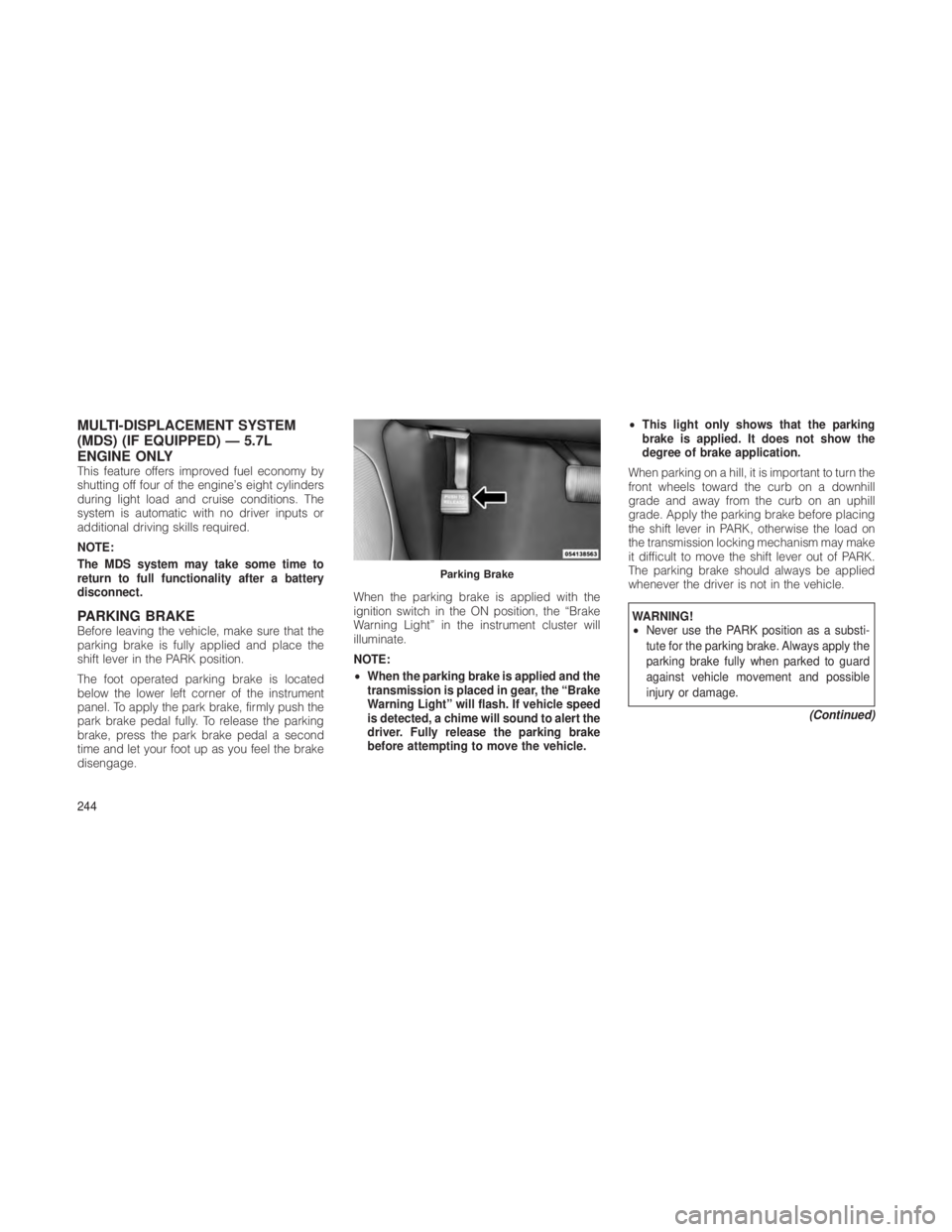
MULTI-DISPLACEMENT SYSTEM
(MDS) (IF EQUIPPED) ŌĆö 5.7L
ENGINE ONLY
This feature offers improved fuel economy by
shutting off four of the engineŌĆÖs eight cylinders
during light load and cruise conditions. The
system is automatic with no driver inputs or
additional driving skills required.
NOTE:
The MDS system may take some time to
return to full functionality after a battery
disconnect.
PARKING BRAKEBefore leaving the vehicle, make sure that the
parking brake is fully applied and place the
shift lever in the PARK position.
The foot operated parking brake is located
below the lower left corner of the instrument
panel. To apply the park brake, firmly push the
park brake pedal fully. To release the parking
brake, press the park brake pedal a second
time and let your foot up as you feel the brake
disengage.When the parking brake is applied with the
ignition switch in the ON position, the ŌĆ£Brake
Warning LightŌĆØ in the instrument cluster will
illuminate.
NOTE:
ŌĆó
When the parking brake is applied and the
transmission is placed in gear, the ŌĆ£Brake
Warning LightŌĆØ will flash. If vehicle speed
is detected, a chime will sound to alert the
driver. Fully release the parking brake
before attempting to move the vehicle. ŌĆó
This light only shows that the parking
brake is applied. It does not show the
degree of brake application.
When parking on a hill, it is important to turn the
front wheels toward the curb on a downhill
grade and away from the curb on an uphill
grade. Apply the parking brake before placing
the shift lever in PARK, otherwise the load on
the transmission locking mechanism may make
it difficult to move the shift lever out of PARK.
The parking brake should always be applied
whenever the driver is not in the vehicle.WARNING!
ŌĆó Never use the PARK position as a substi-
tute for the parking brake. Always apply the
parking brake fully when parked to guard
against vehicle movement and possible
injury or damage.
(Continued)
Parking Brake
244
Page 249 of 380
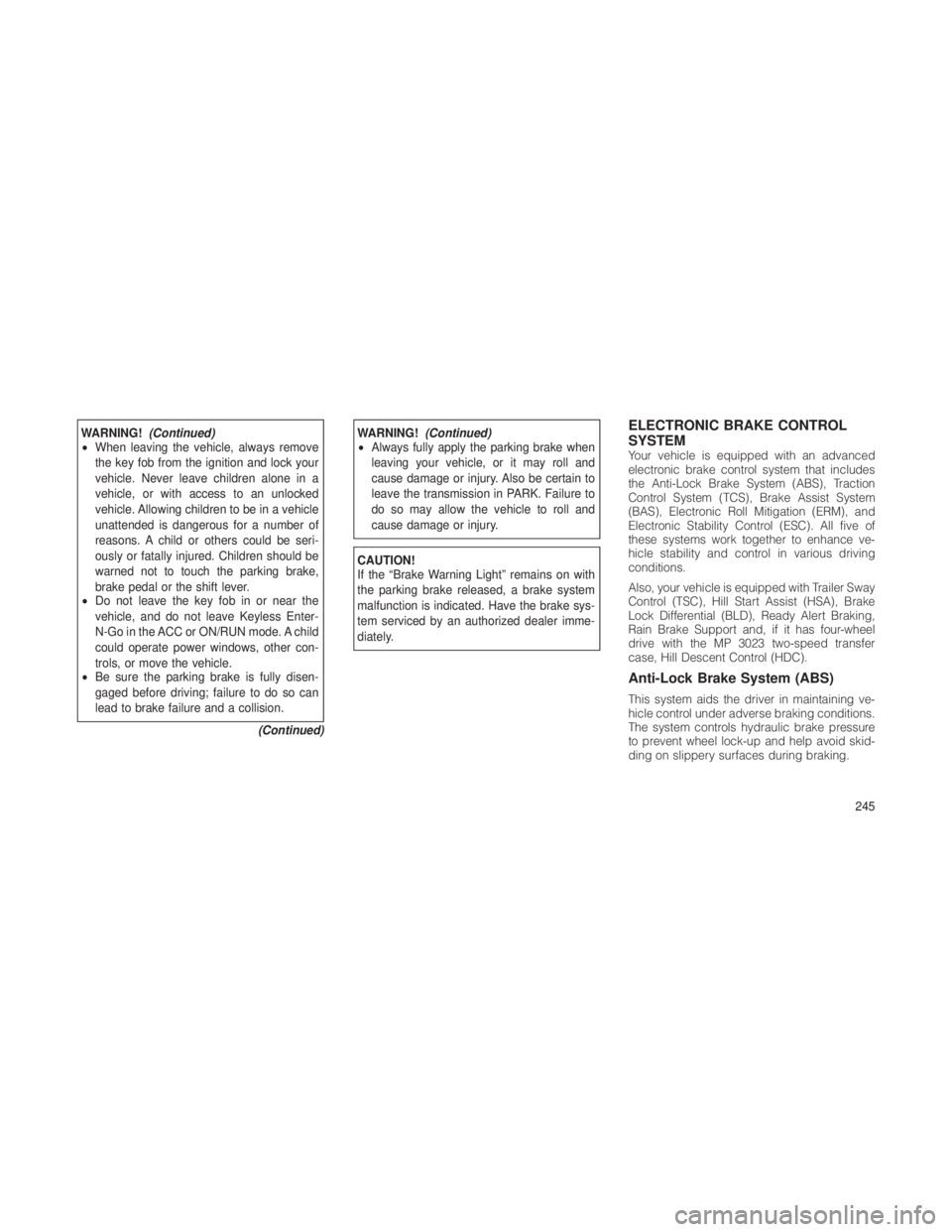
WARNING!(Continued)
ŌĆó When leaving the vehicle, always remove
the key fob from the ignition and lock your
vehicle. Never leave children alone in a
vehicle, or with access to an unlocked
vehicle. Allowing children to be in a vehicle
unattended is dangerous for a number of
reasons. A child or others could be seri-
ously or fatally injured. Children should be
warned not to touch the parking brake,
brake pedal or the shift lever.
ŌĆó Do not leave the key fob in or near the
vehicle, and do not leave Keyless Enter-
N-Go in the ACC or ON/RUN mode. A child
could operate power windows, other con-
trols, or move the vehicle.
ŌĆó Be sure the parking brake is fully disen-
gaged before driving; failure to do so can
lead to brake failure and a collision.
(Continued)WARNING!(Continued)
ŌĆó Always fully apply the parking brake when
leaving your vehicle, or it may roll and
cause damage or injury. Also be certain to
leave the transmission in PARK. Failure to
do so may allow the vehicle to roll and
cause damage or injury.
CAUTION!
If the ŌĆ£Brake Warning LightŌĆØ remains on with
the parking brake released, a brake system
malfunction is indicated. Have the brake sys-
tem serviced by an authorized dealer imme-
diately.
ELECTRONIC BRAKE CONTROL
SYSTEM
Your vehicle is equipped with an advanced
electronic brake control system that includes
the Anti-Lock Brake System (ABS), Traction
Control System (TCS), Brake Assist System
(BAS), Electronic Roll Mitigation (ERM), and
Electronic Stability Control (ESC). All five of
these systems work together to enhance ve-
hicle stability and control in various driving
conditions.
Also, your vehicle is equipped with Trailer Sway
Control (TSC), Hill Start Assist (HSA), Brake
Lock Differential (BLD), Ready Alert Braking,
Rain Brake Support and, if it has four-wheel
drive with the MP 3023 two-speed transfer
case, Hill Descent Control (HDC).
Anti-Lock Brake System (ABS)
This system aids the driver in maintaining ve-
hicle control under adverse braking conditions.
The system controls hydraulic brake pressure
to prevent wheel lock-up and help avoid skid-
ding on slippery surfaces during braking.
245
Page 250 of 380

WARNING!
The ABS cannot prevent the natural laws of
physics from acting on the vehicle, nor can it
increase the traction afforded by prevailing
road conditions. The ABS cannot prevent ac-
cidents, including those resulting from exces-
sive speed in turns, driving on very slippery
surfaces, or hydroplaning. The capabilities of
an ABS-equipped vehicle must never be ex-
ploited in a reckless or dangerous manner
which could jeopardize the userŌĆÖs safety or the
safety of others.
Traction Control System (TCS)
This system monitors the amount of wheel spin
of each of the driven wheels. If wheel spin is
detected, brake pressure is applied to the
slipping wheel(s) and engine power is reduced
to provide enhanced acceleration and stability.
A feature of the TCS system, Brake Limited
Differential (BLD), functions similar to a limited-
slip differential and controls the wheel spin
across a driven axle. If one wheel on a driven
axle is spinning faster than the other, the sys-tem will apply the brake of the spinning wheel.
This will allow more engine torque to be applied
to the wheel that is not spinning. This feature
remains active even if ESC system is in the
ŌĆ£Partial OffŌĆØ mode. Refer to ŌĆ£Electronic Stability
Control (ESC)ŌĆØ in this section for further infor-
mation.
Brake Assist System (BAS)The BAS is designed to optimize the vehicleŌĆÖs
braking capability during emergency braking
maneuvers. The system detects an emergency
braking situation by sensing the rate and
amount of brake application and then applies
optimum pressure to the brakes. This can help
reduce braking distances. The BAS comple-
ments the anti-lock brake system (ABS). Apply-
ing the brakes very quickly results in the best
BAS assistance. To receive the benefit of the
system, you must apply
continuousbraking
pressure during the stopping sequence (do not
ŌĆ£pumpŌĆØ the brakes). Do not reduce brake pedal
pressure unless braking is no longer desired.
Once the brake pedal is released, the BAS is
deactivated.
WARNING!
The BAS cannot prevent the natural laws of
physics from acting on the vehicle, nor can it
increase the traction afforded by prevailing
road conditions. The BAS cannot prevent
accidents, including those resulting from ex-
cessive speed in turns, driving on very slip-
pery surfaces, or hydroplaning. The capabili-
ties of a BAS-equipped vehicle must never be
exploited in a reckless or dangerous manner
which could jeopardize the userŌĆÖs safety or the
safety of others.
Electronic Roll Mitigation (ERM)This system anticipates the potential for wheel
lift by monitoring the driverŌĆÖs steering wheel
input and the speed of the vehicle. When ERM
determines that the rate of change of the steer-
ing wheel angle and vehicle speed are suffi-
cient to potentially cause wheel lift, it then
applies the brake of the appropriate wheel and
may also reduce engine power to lessen the
chance that wheel lift will occur. ERM will only
intervene during very severe or evasive driving
maneuvers.
246
Page 251 of 380
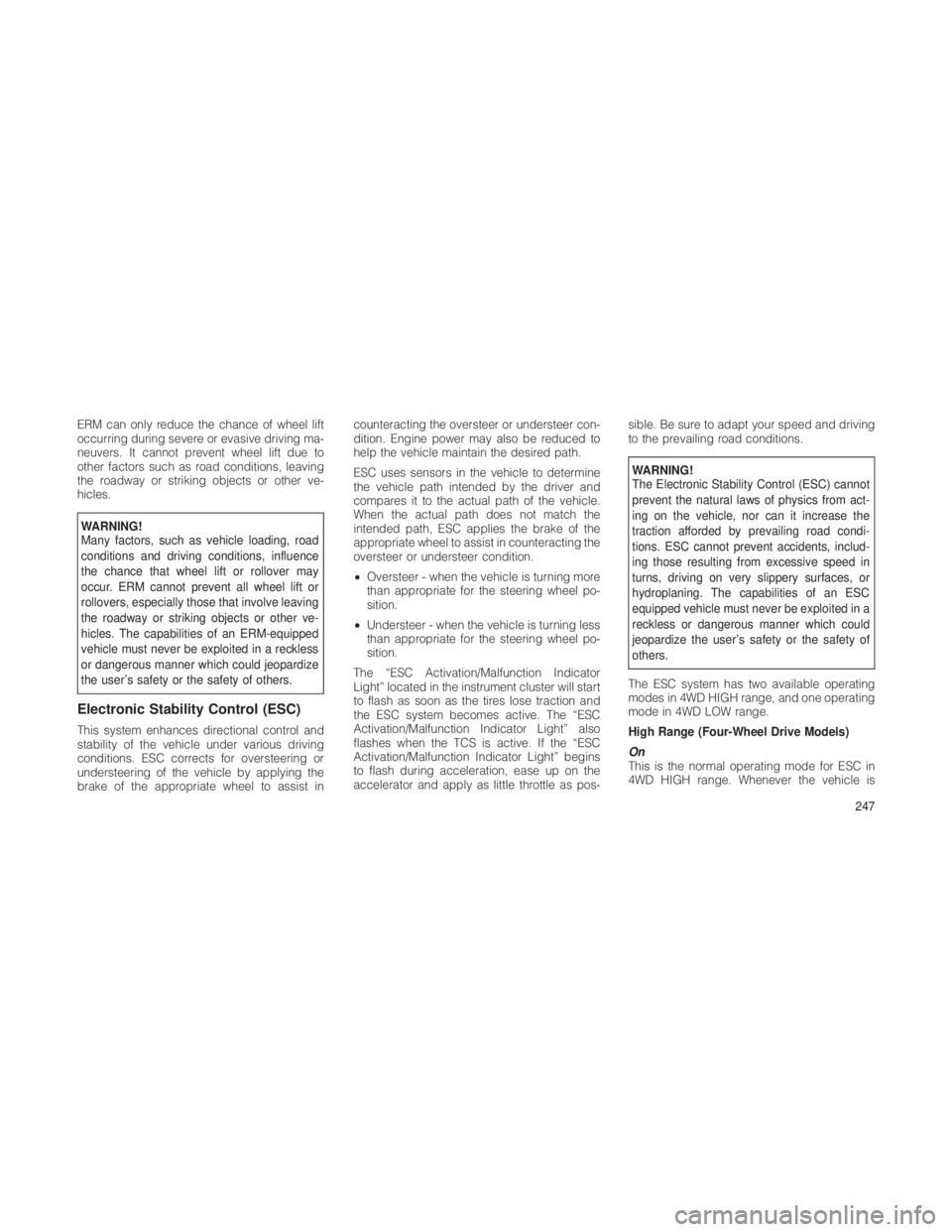
ERM can only reduce the chance of wheel lift
occurring during severe or evasive driving ma-
neuvers. It cannot prevent wheel lift due to
other factors such as road conditions, leaving
the roadway or striking objects or other ve-
hicles.
WARNING!
Many factors, such as vehicle loading, road
conditions and driving conditions, influence
the chance that wheel lift or rollover may
occur. ERM cannot prevent all wheel lift or
rollovers, especially those that involve leaving
the roadway or striking objects or other ve-
hicles. The capabilities of an ERM-equipped
vehicle must never be exploited in a reckless
or dangerous manner which could jeopardize
the userŌĆÖs safety or the safety of others.
Electronic Stability Control (ESC)
This system enhances directional control and
stability of the vehicle under various driving
conditions. ESC corrects for oversteering or
understeering of the vehicle by applying the
brake of the appropriate wheel to assist incounteracting the oversteer or understeer con-
dition. Engine power may also be reduced to
help the vehicle maintain the desired path.
ESC uses sensors in the vehicle to determine
the vehicle path intended by the driver and
compares it to the actual path of the vehicle.
When the actual path does not match the
intended path, ESC applies the brake of the
appropriate wheel to assist in counteracting the
oversteer or understeer condition.
ŌĆó
Oversteer - when the vehicle is turning more
than appropriate for the steering wheel po-
sition.
ŌĆó Understeer - when the vehicle is turning less
than appropriate for the steering wheel po-
sition.
The ŌĆ£ESC Activation/Malfunction Indicator
LightŌĆØ located in the instrument cluster will start
to flash as soon as the tires lose traction and
the ESC system becomes active. The ŌĆ£ESC
Activation/Malfunction Indicator LightŌĆØ also
flashes when the TCS is active. If the ŌĆ£ESC
Activation/Malfunction Indicator LightŌĆØ begins
to flash during acceleration, ease up on the
accelerator and apply as little throttle as pos- sible. Be sure to adapt your speed and driving
to the prevailing road conditions.
WARNING!
The Electronic Stability Control (ESC) cannot
prevent the natural laws of physics from act-
ing on the vehicle, nor can it increase the
traction afforded by prevailing road condi-
tions. ESC cannot prevent accidents, includ-
ing those resulting from excessive speed in
turns, driving on very slippery surfaces, or
hydroplaning. The capabilities of an ESC
equipped vehicle must never be exploited in a
reckless or dangerous manner which could
jeopardize the userŌĆÖs safety or the safety of
others.
The ESC system has two available operating
modes in 4WD HIGH range, and one operating
mode in 4WD LOW range.
High Range (Four-Wheel Drive Models)
On
This is the normal operating mode for ESC in
4WD HIGH range. Whenever the vehicle is 247
Page 253 of 380
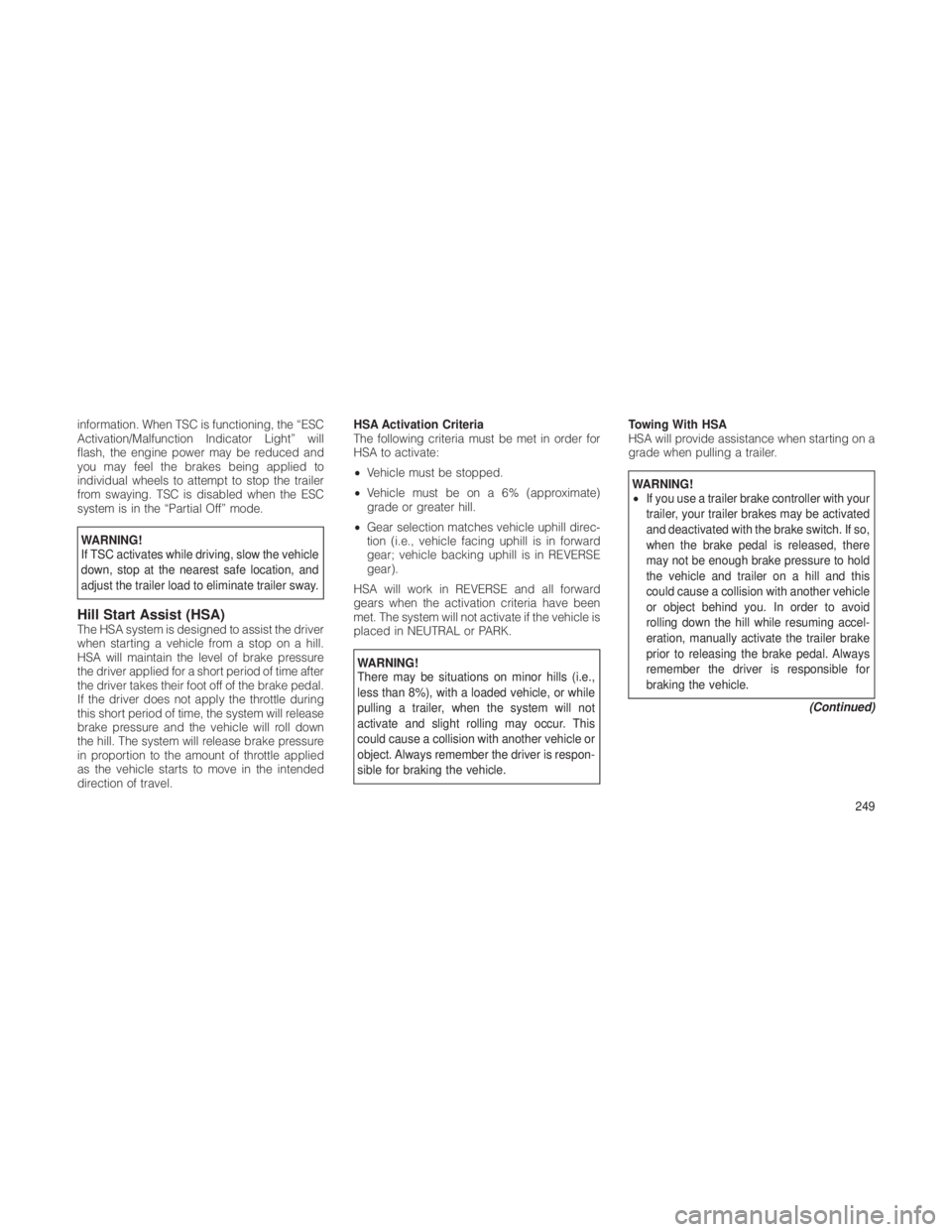
information. When TSC is functioning, the ŌĆ£ESC
Activation/Malfunction Indicator LightŌĆØ will
flash, the engine power may be reduced and
you may feel the brakes being applied to
individual wheels to attempt to stop the trailer
from swaying. TSC is disabled when the ESC
system is in the ŌĆ£Partial OffŌĆØ mode.
WARNING!
If TSC activates while driving, slow the vehicle
down, stop at the nearest safe location, and
adjust the trailer load to eliminate trailer sway.
Hill Start Assist (HSA)The HSA system is designed to assist the driver
when starting a vehicle from a stop on a hill.
HSA will maintain the level of brake pressure
the driver applied for a short period of time after
the driver takes their foot off of the brake pedal.
If the driver does not apply the throttle during
this short period of time, the system will release
brake pressure and the vehicle will roll down
the hill. The system will release brake pressure
in proportion to the amount of throttle applied
as the vehicle starts to move in the intended
direction of travel.HSA Activation Criteria
The following criteria must be met in order for
HSA to activate:
ŌĆó
Vehicle must be stopped.
ŌĆó Vehicle must be on a 6% (approximate)
grade or greater hill.
ŌĆó Gear selection matches vehicle uphill direc-
tion (i.e., vehicle facing uphill is in forward
gear; vehicle backing uphill is in REVERSE
gear).
HSA will work in REVERSE and all forward
gears when the activation criteria have been
met. The system will not activate if the vehicle is
placed in NEUTRAL or PARK.
WARNING!
There may be situations on minor hills (i.e.,
less than 8%), with a loaded vehicle, or while
pulling a trailer, when the system will not
activate and slight rolling may occur. This
could cause a collision with another vehicle or
object. Always remember the driver is respon-
sible for braking the vehicle. Towing With HSA
HSA will provide assistance when starting on a
grade when pulling a trailer.
WARNING!
ŌĆó
If you use a trailer brake controller with your
trailer, your trailer brakes may be activated
and deactivated with the brake switch. If so,
when the brake pedal is released, there
may not be enough brake pressure to hold
the vehicle and trailer on a hill and this
could cause a collision with another vehicle
or object behind you. In order to avoid
rolling down the hill while resuming accel-
eration, manually activate the trailer brake
prior to releasing the brake pedal. Always
remember the driver is responsible for
braking the vehicle.
(Continued)
249
Page 254 of 380
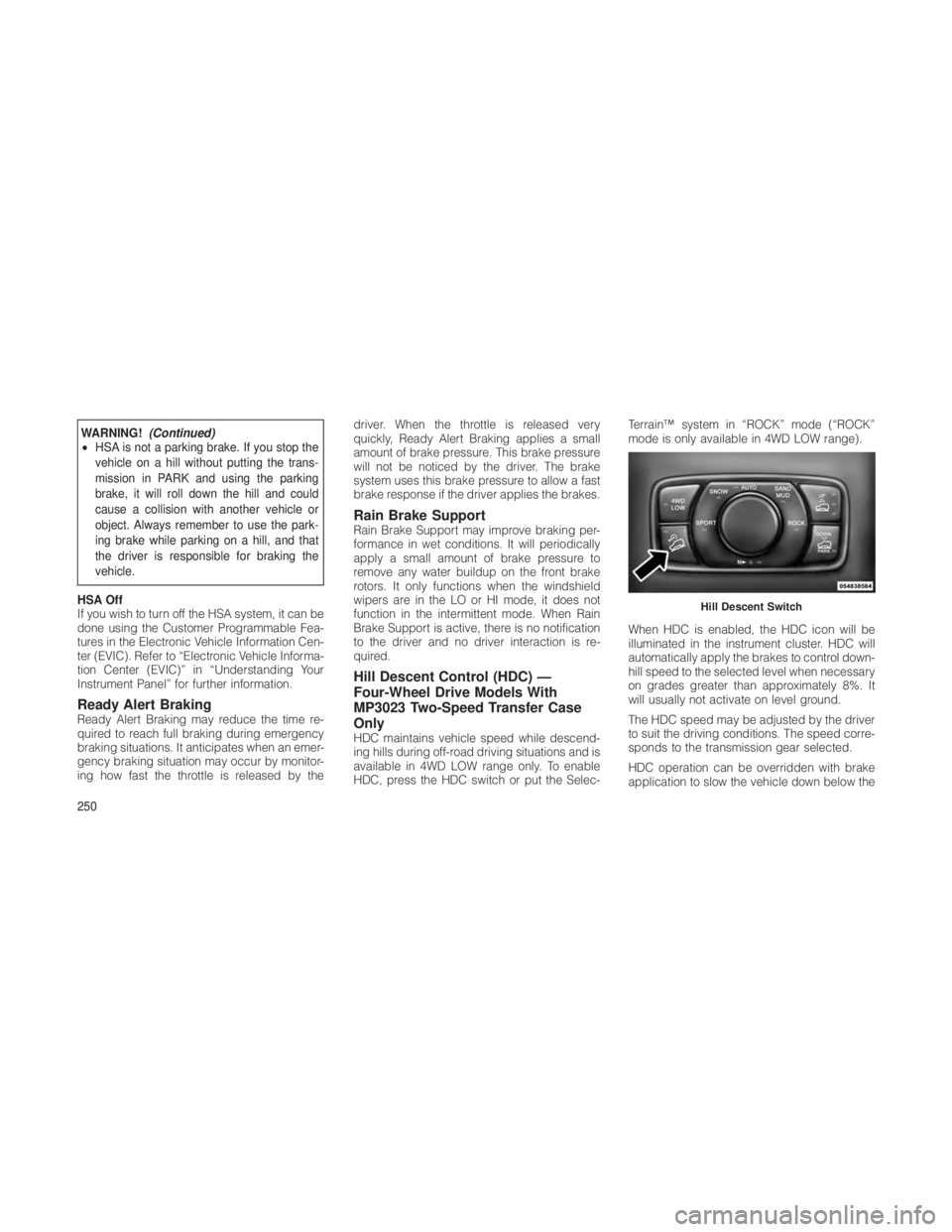
WARNING!(Continued)
ŌĆó HSA is not a parking brake. If you stop the
vehicle on a hill without putting the trans-
mission in PARK and using the parking
brake, it will roll down the hill and could
cause a collision with another vehicle or
object. Always remember to use the park-
ing brake while parking on a hill, and that
the driver is responsible for braking the
vehicle.
HSA Off
If you wish to turn off the HSA system, it can be
done using the Customer Programmable Fea-
tures in the Electronic Vehicle Information Cen-
ter (EVIC). Refer to ŌĆ£Electronic Vehicle Informa-
tion Center (EVIC)ŌĆØ in ŌĆ£Understanding Your
Instrument PanelŌĆØ for further information.
Ready Alert BrakingReady Alert Braking may reduce the time re-
quired to reach full braking during emergency
braking situations. It anticipates when an emer-
gency braking situation may occur by monitor-
ing how fast the throttle is released by the driver. When the throttle is released very
quickly, Ready Alert Braking applies a small
amount of brake pressure. This brake pressure
will not be noticed by the driver. The brake
system uses this brake pressure to allow a fast
brake response if the driver applies the brakes.
Rain Brake SupportRain Brake Support may improve braking per-
formance in wet conditions. It will periodically
apply a small amount of brake pressure to
remove any water buildup on the front brake
rotors. It only functions when the windshield
wipers are in the LO or HI mode, it does not
function in the intermittent mode. When Rain
Brake Support is active, there is no notification
to the driver and no driver interaction is re-
quired.
Hill Descent Control (HDC) ŌĆö
Four-Wheel Drive Models With
MP3023 Two-Speed Transfer Case
Only
HDC maintains vehicle speed while descend-
ing hills during off-road driving situations and is
available in 4WD LOW range only. To enable
HDC, press the HDC switch or put the Selec-TerrainŌäó system in ŌĆ£ROCKŌĆØ mode (ŌĆ£ROCKŌĆØ
mode is only available in 4WD LOW range).
When HDC is enabled, the HDC icon will be
illuminated in the instrument cluster. HDC will
automatically apply the brakes to control down-
hill speed to the selected level when necessary
on grades greater than approximately 8%. It
will usually not activate on level ground.
The HDC speed may be adjusted by the driver
to suit the driving conditions. The speed corre-
sponds to the transmission gear selected.
HDC operation can be overridden with brake
application to slow the vehicle down below the
Hill Descent Switch
250
Page 255 of 380
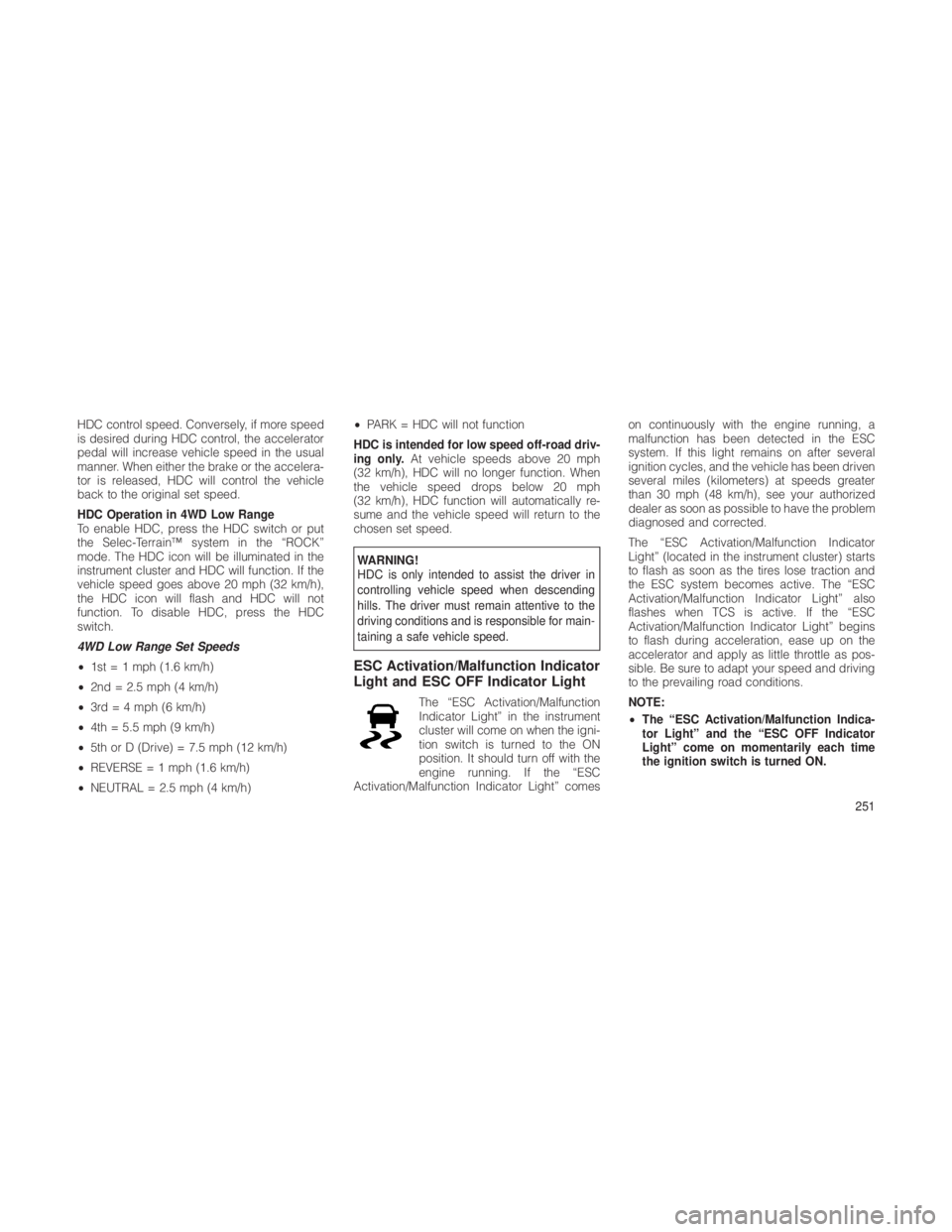
HDC control speed. Conversely, if more speed
is desired during HDC control, the accelerator
pedal will increase vehicle speed in the usual
manner. When either the brake or the accelera-
tor is released, HDC will control the vehicle
back to the original set speed.
HDC Operation in 4WD Low Range
To enable HDC, press the HDC switch or put
the Selec-TerrainŌäó system in the ŌĆ£ROCKŌĆØ
mode. The HDC icon will be illuminated in the
instrument cluster and HDC will function. If the
vehicle speed goes above 20 mph (32 km/h),
the HDC icon will flash and HDC will not
function. To disable HDC, press the HDC
switch.
4WD Low Range Set Speeds
ŌĆó1st = 1 mph (1.6 km/h)
ŌĆó 2nd = 2.5 mph (4 km/h)
ŌĆó 3rd = 4 mph (6 km/h)
ŌĆó 4th = 5.5 mph (9 km/h)
ŌĆó 5th or D (Drive) = 7.5 mph (12 km/h)
ŌĆó REVERSE = 1 mph (1.6 km/h)
ŌĆó NEUTRAL = 2.5 mph (4 km/h) ŌĆó
PARK = HDC will not function
HDC is intended for low speed off-road driv-
ing only. At vehicle speeds above 20 mph
(32 km/h), HDC will no longer function. When
the vehicle speed drops below 20 mph
(32 km/h), HDC function will automatically re-
sume and the vehicle speed will return to the
chosen set speed.
WARNING!
HDC is only intended to assist the driver in
controlling vehicle speed when descending
hills. The driver must remain attentive to the
driving conditions and is responsible for main-
taining a safe vehicle speed.
ESC Activation/Malfunction Indicator
Light and ESC OFF Indicator Light
The ŌĆ£ESC Activation/Malfunction
Indicator LightŌĆØ in the instrument
cluster will come on when the igni-
tion switch is turned to the ON
position. It should turn off with the
engine running. If the ŌĆ£ESC
Activation/Malfunction Indicator LightŌĆØ comes on continuously with the engine running, a
malfunction has been detected in the ESC
system. If this light remains on after several
ignition cycles, and the vehicle has been driven
several miles (kilometers) at speeds greater
than 30 mph (48 km/h), see your authorized
dealer as soon as possible to have the problem
diagnosed and corrected.
The ŌĆ£ESC Activation/Malfunction Indicator
LightŌĆØ (located in the instrument cluster) starts
to flash as soon as the tires lose traction and
the ESC system becomes active. The ŌĆ£ESC
Activation/Malfunction Indicator LightŌĆØ also
flashes when TCS is active. If the ŌĆ£ESC
Activation/Malfunction Indicator LightŌĆØ begins
to flash during acceleration, ease up on the
accelerator and apply as little throttle as pos-
sible. Be sure to adapt your speed and driving
to the prevailing road conditions.
NOTE:
ŌĆó
The ŌĆ£ESC Activation/Malfunction Indica-
tor LightŌĆØ and the ŌĆ£ESC OFF Indicator
LightŌĆØ come on momentarily each time
the ignition switch is turned ON.
251
Page 256 of 380
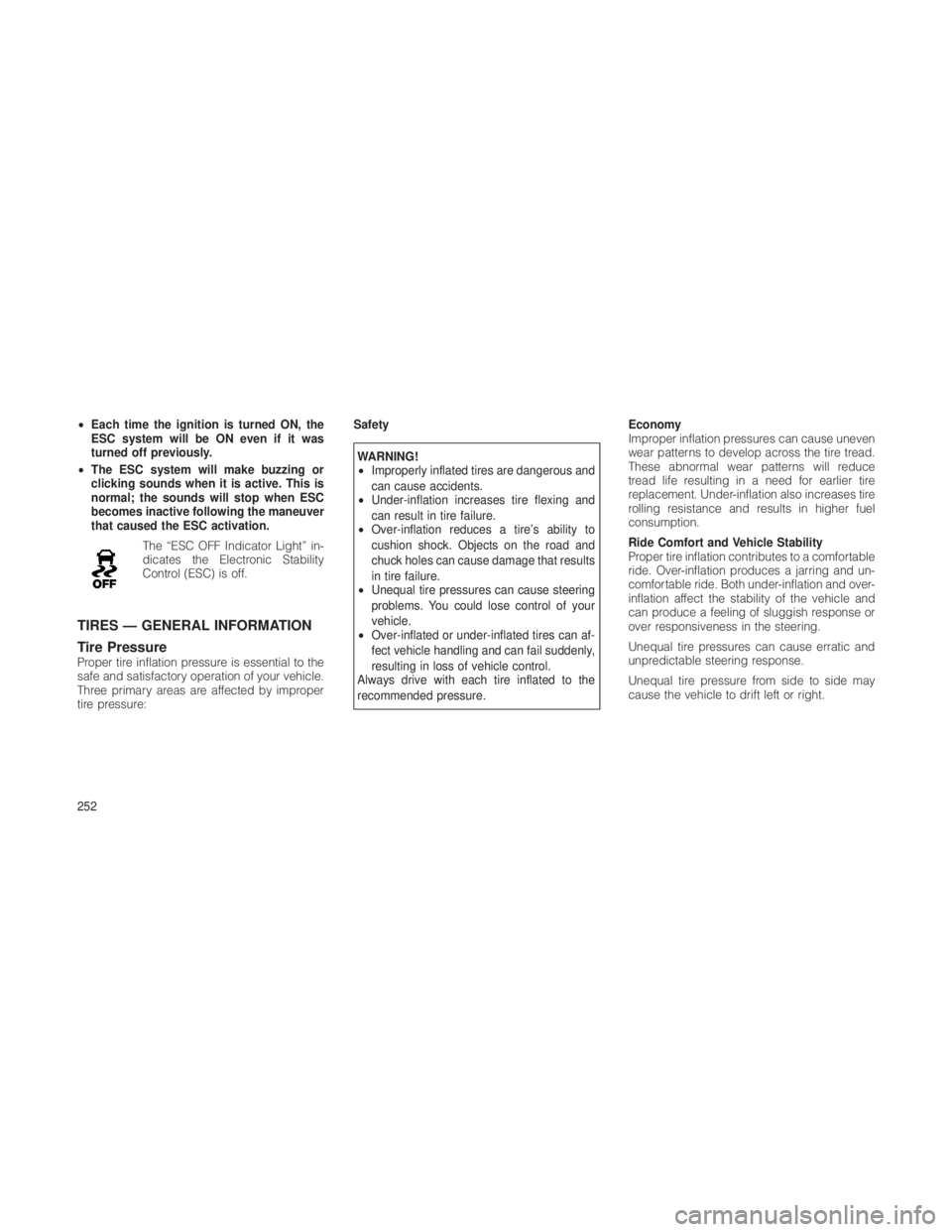
ŌĆóEach time the ignition is turned ON, the
ESC system will be ON even if it was
turned off previously.
ŌĆó The ESC system will make buzzing or
clicking sounds when it is active. This is
normal; the sounds will stop when ESC
becomes inactive following the maneuver
that caused the ESC activation.
The ŌĆ£ESC OFF Indicator LightŌĆØ in-
dicates the Electronic Stability
Control (ESC) is off.
TIRES ŌĆö GENERAL INFORMATION
Tire Pressure
Proper tire inflation pressure is essential to the
safe and satisfactory operation of your vehicle.
Three primary areas are affected by improper
tire pressure: Safety
WARNING!
ŌĆó
Improperly inflated tires are dangerous and
can cause accidents.
ŌĆó Under-inflation increases tire flexing and
can result in tire failure.
ŌĆó Over-inflation reduces a tireŌĆÖs ability to
cushion shock. Objects on the road and
chuck holes can cause damage that results
in tire failure.
ŌĆó Unequal tire pressures can cause steering
problems. You could lose control of your
vehicle.
ŌĆó Over-inflated or under-inflated tires can af-
fect vehicle handling and can fail suddenly,
resulting in loss of vehicle control.
Always drive with each tire inflated to the
recommended pressure. Economy
Improper inflation pressures can cause uneven
wear patterns to develop across the tire tread.
These abnormal wear patterns will reduce
tread life resulting in a need for earlier tire
replacement. Under-inflation also increases tire
rolling resistance and results in higher fuel
consumption.
Ride Comfort and Vehicle Stability
Proper tire inflation contributes to a comfortable
ride. Over-inflation produces a jarring and un-
comfortable ride. Both under-inflation and over-
inflation affect the stability of the vehicle and
can produce a feeling of sluggish response or
over responsiveness in the steering.
Unequal tire pressures can cause erratic and
unpredictable steering response.
Unequal tire pressure from side to side may
cause the vehicle to drift left or right.
252
Page 257 of 380
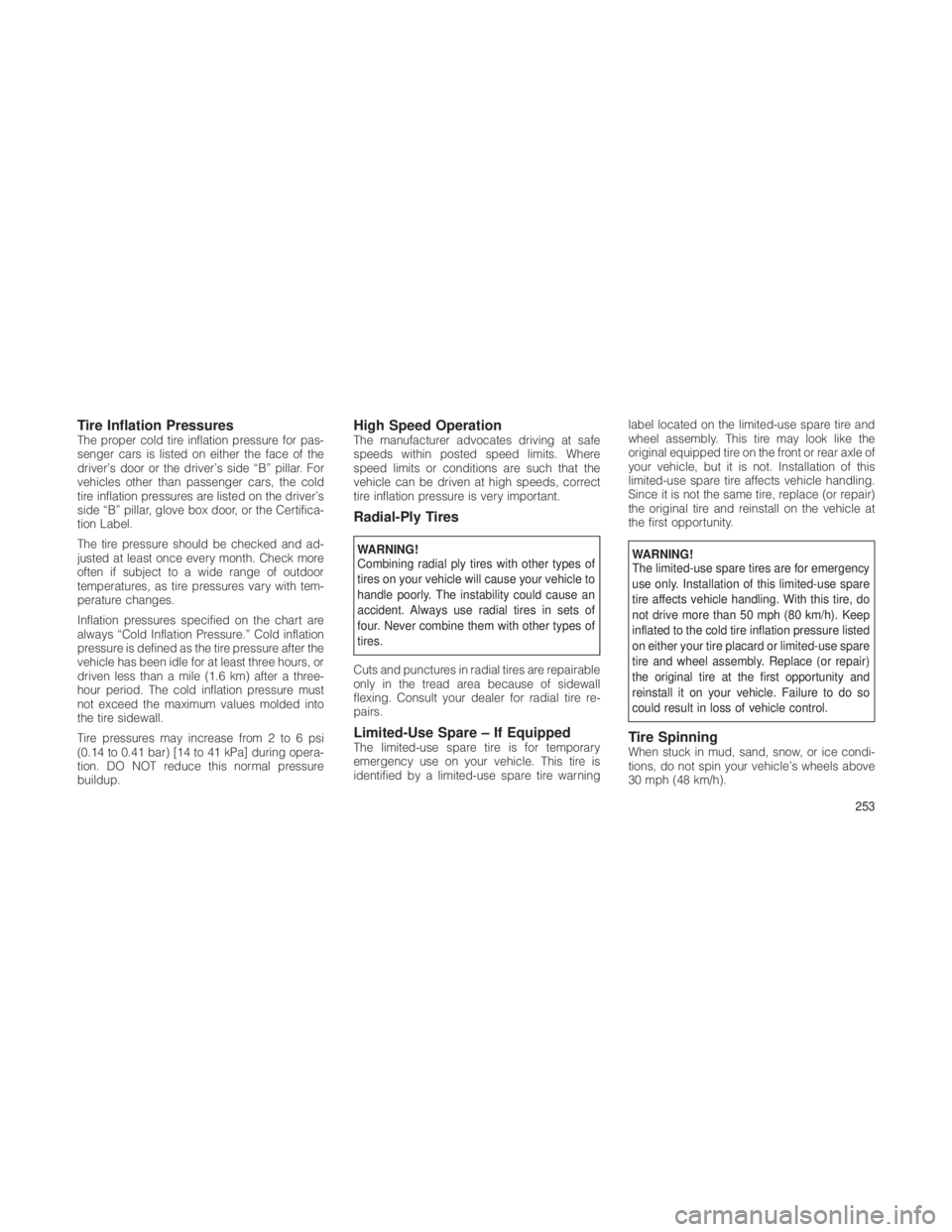
Tire Inflation PressuresThe proper cold tire inflation pressure for pas-
senger cars is listed on either the face of the
driverŌĆÖs door or the driverŌĆÖs side ŌĆ£BŌĆØ pillar. For
vehicles other than passenger cars, the cold
tire inflation pressures are listed on the driverŌĆÖs
side ŌĆ£BŌĆØ pillar, glove box door, or the Certifica-
tion Label.
The tire pressure should be checked and ad-
justed at least once every month. Check more
often if subject to a wide range of outdoor
temperatures, as tire pressures vary with tem-
perature changes.
Inflation pressures specified on the chart are
always ŌĆ£Cold Inflation Pressure.ŌĆØ Cold inflation
pressure is defined as the tire pressure after the
vehicle has been idle for at least three hours, or
driven less than a mile (1.6 km) after a three-
hour period. The cold inflation pressure must
not exceed the maximum values molded into
the tire sidewall.
Tire pressures may increase from 2 to 6 psi
(0.14 to 0.41 bar) [14 to 41 kPa] during opera-
tion. DO NOT reduce this normal pressure
buildup.High Speed OperationThe manufacturer advocates driving at safe
speeds within posted speed limits. Where
speed limits or conditions are such that the
vehicle can be driven at high speeds, correct
tire inflation pressure is very important.
Radial-Ply Tires
WARNING!
Combining radial ply tires with other types of
tires on your vehicle will cause your vehicle to
handle poorly. The instability could cause an
accident. Always use radial tires in sets of
four. Never combine them with other types of
tires.
Cuts and punctures in radial tires are repairable
only in the tread area because of sidewall
flexing. Consult your dealer for radial tire re-
pairs.
Limited-Use Spare ŌĆō If EquippedThe limited-use spare tire is for temporary
emergency use on your vehicle. This tire is
identified by a limited-use spare tire warning label located on the limited-use spare tire and
wheel assembly. This tire may look like the
original equipped tire on the front or rear axle of
your vehicle, but it is not. Installation of this
limited-use spare tire affects vehicle handling.
Since it is not the same tire, replace (or repair)
the original tire and reinstall on the vehicle at
the first opportunity.
WARNING!
The limited-use spare tires are for emergency
use only. Installation of this limited-use spare
tire affects vehicle handling. With this tire, do
not drive more than 50 mph (80 km/h). Keep
inflated to the cold tire inflation pressure listed
on either your tire placard or limited-use spare
tire and wheel assembly. Replace (or repair)
the original tire at the first opportunity and
reinstall it on your vehicle. Failure to do so
could result in loss of vehicle control.
Tire SpinningWhen stuck in mud, sand, snow, or ice condi-
tions, do not spin your vehicleŌĆÖs wheels above
30 mph (48 km/h).
253
Page 258 of 380
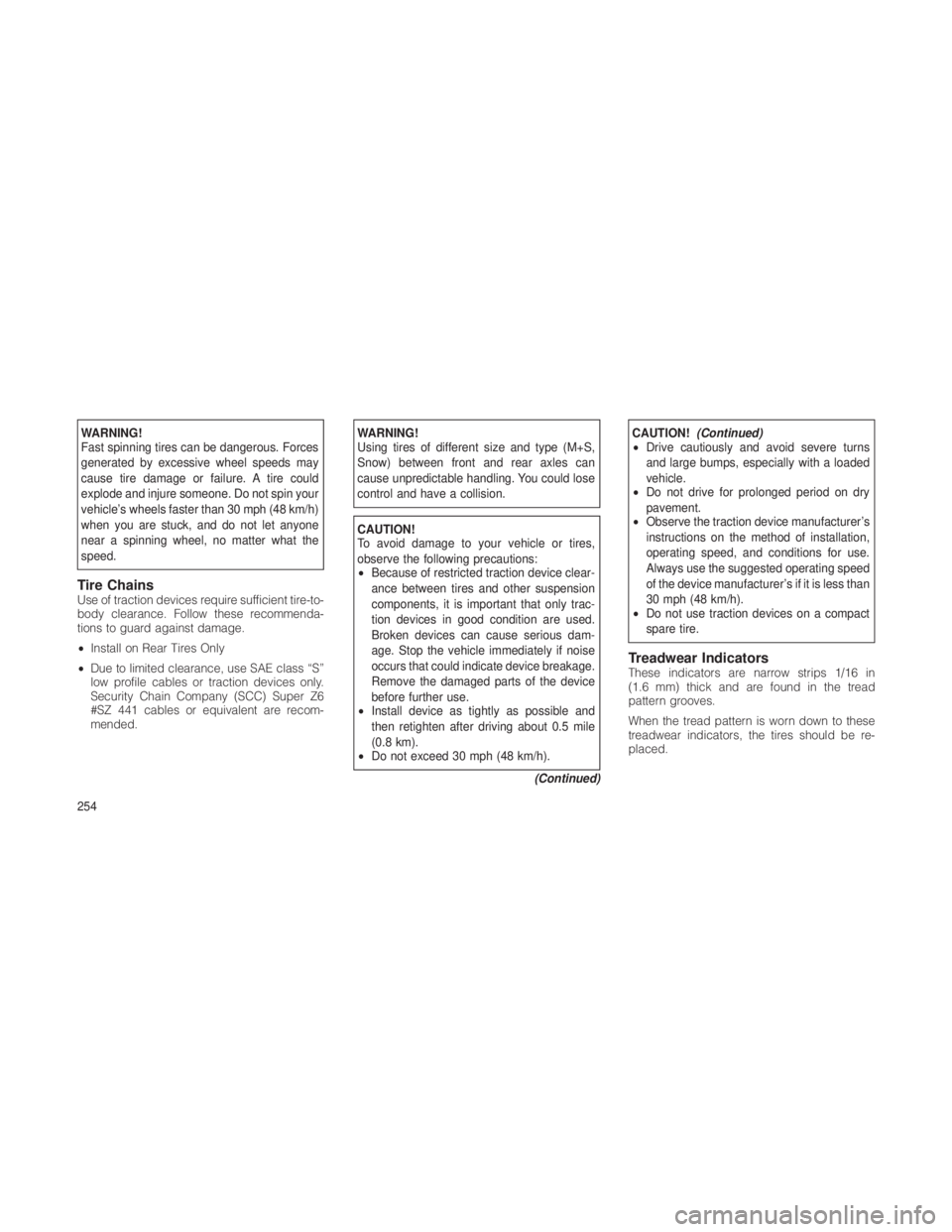
WARNING!
Fast spinning tires can be dangerous. Forces
generated by excessive wheel speeds may
cause tire damage or failure. A tire could
explode and injure someone. Do not spin your
vehicleŌĆÖs wheels faster than 30 mph (48 km/h)
when you are stuck, and do not let anyone
near a spinning wheel, no matter what the
speed.
Tire ChainsUse of traction devices require sufficient tire-to-
body clearance. Follow these recommenda-
tions to guard against damage.
ŌĆóInstall on Rear Tires Only
ŌĆó Due to limited clearance, use SAE class ŌĆ£SŌĆØ
low profile cables or traction devices only.
Security Chain Company (SCC) Super Z6
#SZ 441 cables or equivalent are recom-
mended.
WARNING!
Using tires of different size and type (M+S,
Snow) between front and rear axles can
cause unpredictable handling. You could lose
control and have a collision.
CAUTION!
To avoid damage to your vehicle or tires,
observe the following precautions:
ŌĆó Because of restricted traction device clear-
ance between tires and other suspension
components, it is important that only trac-
tion devices in good condition are used.
Broken devices can cause serious dam-
age. Stop the vehicle immediately if noise
occurs that could indicate device breakage.
Remove the damaged parts of the device
before further use.
ŌĆó Install device as tightly as possible and
then retighten after driving about 0.5 mile
(0.8 km).
ŌĆó Do not exceed 30 mph (48 km/h).
(Continued)
CAUTION!(Continued)
ŌĆó Drive cautiously and avoid severe turns
and large bumps, especially with a loaded
vehicle.
ŌĆó Do not drive for prolonged period on dry
pavement.
ŌĆó Observe the traction device manufacturerŌĆÖs
instructions on the method of installation,
operating speed, and conditions for use.
Always use the suggested operating speed
of the device manufacturerŌĆÖs if it is less than
30 mph (48 km/h).
ŌĆó Do not use traction devices on a compact
spare tire.
Treadwear IndicatorsThese indicators are narrow strips 1/16 in
(1.6 mm) thick and are found in the tread
pattern grooves.
When the tread pattern is worn down to these
treadwear indicators, the tires should be re-
placed.
254